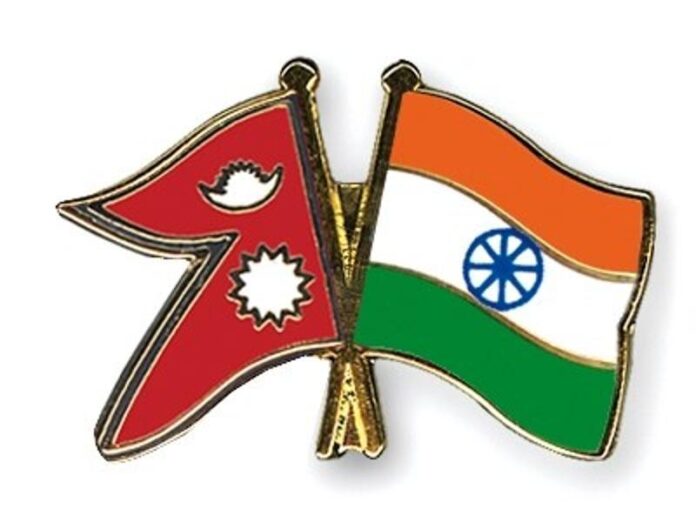Nepal and India share a relationship that is deeply rooted in history, culture, and geography. The ties between these two countries are as ancient as human civilization itself. The profound connections between Nepal and India are unparalleled, and they span across various domains including geography, culture, social structures, economics, religion, and language. These strong foundations have ensured that even minor political disputes do not significantly affect the underlying bond between the two nations. In true sense, they are friends in need, friends indeed.

Ravindra Ojha
Geographical Proximity
The geographical contiguity between Nepal and India has played a crucial role in shaping their relationship. The Himalayas form a natural boundary to the north of Nepal, while the southern, eastern, and western borders are shared with India. This close proximity has facilitated extensive interaction and exchange between the people of both nations for centuries. The open border policy, which allows citizens of both countries to move freely across the border, has further strengthened these ties.
Historically, the relationship between Nepal and India has been marked by mutual cooperation and support. India has been a proactive partner in Nepal’s development efforts, especially in areas such as infrastructure, education, health, energy, water resources, disaster management, and cross-border connectivity. For instance, Nepal’s first two development plans, starting in 1956, were largely financed by India. This collaboration has significantly transformed the development landscape in Nepal, benefiting both countries.
Economic Interdependence
Nepal’s economy is closely intertwined with India’s. Due to its landlocked nature, Nepal relies heavily on India for access to international markets. Most of Nepal’s trade with other countries occurs through Indian territory. India is Nepal’s largest trading partner, and the economic interdependence between the two nations is evident in various sectors.
One notable example of economic cooperation is the energy sector. In 2023, Nepal sold green energy worth INR 9.6 billion to India, a figure that is expected to rise to INR 15.6 billion in 2024, representing a significant increase of over 61 percent. This growing energy trade not only boosts Nepal’s economy but also contributes to India’s energy needs. Additionally, the two countries are working on resolving issues related to the 6,480 MW Pancheshwar project, which was planned in 1996 on the Mahakali River along the Nepal-India border. This project aims to generate power, provide irrigation, and control floods, offering substantial benefits to both nations.
Several other mega hydropower projects, such as the Arun 3 project, are also underway in Nepal. These projects have the potential to further enhance the economic ties between Nepal and India, contributing to the overall development and prosperity of the region.
Cultural and Social Bonds
The cultural and social bonds between Nepal and India are profound and deeply rooted. Both countries share a common cultural heritage, with strong influences from Hinduism and Buddhism. Festivals, rituals, and traditions are often similar, fostering a sense of unity and shared identity among the people.
The open border policy has facilitated frequent cross-border movement, leading to strong social connections. Marriages between people from Nepal and India are common, further cementing the ties between the two nations. This “roti-beti” (bread and daughter) relationship symbolizes the close kinship and interdependence between the people.
Border Disputes
Despite the strong foundation of friendship, Nepal and India have faced challenges, particularly related to border disputes. The areas of Kalapani, Limpiyadhura, and Lipulekh, located along the trijunction point between Nepal, India, and China, have been contentious. Both Nepal and India claim these areas as part of their territories.
The issue escalated in 2015 when India and China agreed to use the Lipulekh pass for trade without consulting Nepal. In response, Nepal amended its constitution to incorporate the disputed areas into its territory and released a new map in 2020. India, however, rejected Nepal’s claims over these regions.
Recently, the Nepalese government decided to feature the new map, including the disputed areas, on the 100-rupee denomination notes. This move was criticized by Chiranjibi Nepal, former Governor of Nepal Rastra Bank, who argued that printing a map different from what international bodies recognize was unwise. This controversy highlights the complexities and sensitivities surrounding the border disputes.
The Treaty of Sugauli
The Treaty of Sugauli, signed in 1816 between the East India Company and Nepal, formally delineated the border between Nepal and India. Since then, the border has remained open, allowing citizens of both countries to cross freely for various purposes such as education, healthcare, business, trade, and social interactions. This open border system has been a lifeline for people living on both sides.
However, some elements in Nepal have recently advocated for introducing a passport system and fencing the border with barbed wire to curb crime and smuggling. These proposals have sparked debates on whether the open border system is responsible for these issues or if other factors, such as the failure of intelligence and security agencies, are at play. For instance, the Tribhuvan International Airport in Kathmandu has emerged as a hub of gold smuggling despite stringent security measures, indicating that criminal activities often have deeper roots and may involve high-profile patronage.
Security and Surveillance
Despite the challenges, the border between Nepal and India is not entirely open and unregulated. Both countries have deployed security forces to patrol their respective border regions. The Border Security Force (BSF) in India and the Armed Police Force (APF) in Nepal monitor the border, and powerful surveillance cameras have been installed. Vehicles crossing the border are recorded, and customs officials regulate the entry and exit of goods.
Regular meetings between the security agencies of both countries help assess the situation along the border and address any issues that arise. To enhance border management, Nepal’s Supreme Court has recently ordered the government to stop all criminal activities along the Nepal-India border using modern equipment and technologies like drones and CCTV cameras. Additionally, the court has urged the government to resolve border disputes through diplomatic channels and restore missing and broken border pillars.
Diplomatic Efforts
Nepal and India have completed 98 percent of the survey work on their 1853 km long international border, indicating that boundary issues are limited to specific areas. The majority of the border regions are peaceful, with people living in harmony. However, vested interests often attempt to disturb this peace by exploiting contentious issues.
Given the multi-faceted and unique relations between the people of Nepal and India, there is no reason why border disputes in areas like Kalapani, Limpiyadhura, and Lipulekh, as well as Susta, cannot be resolved through dialogue and diplomatic channels. The strong foundation of friendship and cooperation between the two nations provides a solid basis for addressing these issues amicably.
Frankly speaking, Nepal-India relations are characterized by deep-rooted historical, cultural, social, economic, and geographical ties. Despite occasional challenges and disputes, the enduring bond between the two countries has remained strong. The open border system, economic interdependence, and cultural affinity have fostered a unique partnership that benefits both nations. By addressing border disputes through diplomatic means and enhancing cooperation in various sectors, Nepal and India can continue to strengthen their relationship and work towards mutual development and prosperity.


